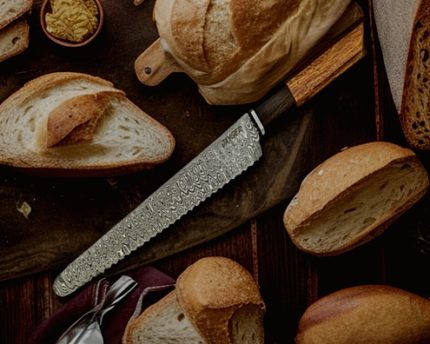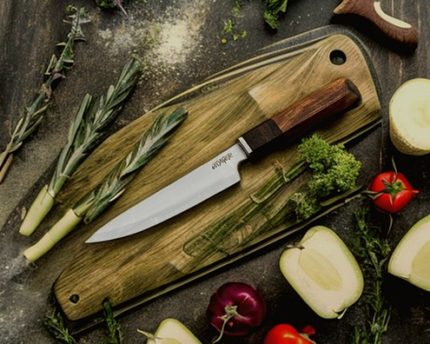Experience Culinary Excellence with Japanese Knives
Are you a passionate home cook or a professional chef looking to elevate your culinary skills? Look no further than the world of the best Japanese knives. Renowned for their exceptional craftsmanship and razor-sharp precision, Japanese Chef Knives Uk have long been revered as the ultimate tool for the discerning chef. Whether you’re
slicing through delicate sashimi or dicing vegetables with precision, these knives are designed to deliver unparalleled performance and cooking experience. With a history dating back centuries, the art of Japanese knife-making combines centuries-old tradition with modern technology, resulting in blades that are not only aesthetically stunning but also incredibly functional.
This article will explore Japanese knives, their unique features, the different types available, and how to choose the perfect one for your needs. Get ready to unleash your inner culinary artist and experience the true essence of Japanese culinary excellence with these extraordinary knives.
The History and Craftsmanship of Japanese Knives
Japanese knife-making is an art form honed and perfected over centuries. The history of Japanese knives can be traced back to the days of the samurai when swordsmiths began applying their expertise to create kitchen knife sets. These early blades were known for their strength, sharpness, and durability. Over time, Japanese knife-making evolved into a highly specialized craft, with each region developing its unique techniques and styles.
One of the key factors that sets Japanese knives apart is the quality of the steel used. Traditional Japanese knives are typically made from high-carbon steel, which allows for a sharper edge and better edge retention. Forging a Japanese knife involves heating the steel to a high temperature, then repeatedly folding and hammering it to create layers. This makes a blade with a distinct pattern known as Damascus, which adds to the knife’s beauty and enhances its strength and flexibility.
Japanese knife-makers also place a strong emphasis on the handle of the knife. Traditional Japanese knives feature a wooden handle, often made from magnolia or hot wood, which is lightweight and comfortable to hold. The handle is meticulously crafted to provide a secure grip, allowing for precise control and maneuverability.
Types of Japanese Knives and Their Uses
Japanese knives come in various shapes and sizes, each with its specific purpose. Understanding the different types of Japanese knives will help you choose the right tool for the task.
- Gyuto: The Gyuto, the chef’s knife, is the most versatile and commonly used Japanese knife. Its curved blade has a pointed tip, making it ideal for a wide range of cutting tasks, from slicing and dicing to chopping and mincing.
- Santoku: The Santoku knife is another popular choice among home cooks. With its shorter, wider blade and flat edge, the Santoku excels at slicing, dicing, and chopping vegetables, making it perfect for everyday cooking.
- Deba: The Deba knife is a heavy-duty knife primarily used for filleting fish and butchering meat. It has a thick, sturdy blade that can handle the challenging task of breaking down bones and cutting through tough skin.
- Sujihiki: The Sujihiki knife, also known as the slicing knife, is designed for precision slicing. Its long, narrow blade allows for clean, thin cuts, making it ideal for slicing raw fish for sashimi or carving roast meats.
- Nakiri: The Nakiri knife is a vegetable-centric knife with a straight, rectangular blade. It excels at slicing and dicing vegetables, with its flat edge making it easier to achieve a clean, even cut.
- Yanagiba: The Yanagiba knife is a traditional Japanese knife for slicing raw fish for sushi and sashimi. Its long, thin blade allows for precise, delicate cuts, ensuring the fish retains its flavor and texture.
These are just a few examples of the many types of Japanese knives available. Each knife is crafted with a specific purpose, allowing chefs to achieve the utmost precision and control in their culinary creations.
Why Do People Like Japanese Knives?
For several reasons, Japanese knives have gained a cult following among professional chefs and home cooks. One of the main reasons people love Japanese knives is their exceptional sharpness. These knives are renowned for their razor-sharp edges, which allow for effortless cutting and clean, precise slices. The high-carbon steel used in Japanese knives can be sharpened to a finer edge than most Western knives, resulting in superior cutting performance.
Another reason people are drawn to Japanese knives is their exquisite craftsmanship. Each knife is handcrafted by skilled artisans who take pride in their work. From the forging of the blade to the shaping of the handle, every step in the knife-making process is carried out with meticulous attention to detail. The result is a knife that performs flawlessly and looks stunning in the kitchen.
Japanese knives are also known for their balance and manoeuvrability. These knives’ careful design and construction ensure they feel comfortable in hand, allowing for extended use without fatigue. The balance of a Japanese steak knife set is achieved by carefully distributing the weight between the blade and handle, creating a knife that feels like an extension of the chef’s hand.
Why Do Chefs Prefer Japanese Knives?
Professional chefs worldwide have embraced Japanese knives for their superior performance and precision. These knives offer control and finesse unmatched by their Western counterparts. The sharpness of the blades allows for effortless cutting, making it easier to achieve precise slices and delicate cuts. This is especially important in the world of sushi and sashimi, where the quality of the amount directly impacts the taste and presentation of the dish.
Japanese knives also excel in terms of durability and edge retention. The high-carbon steel used in these knives is more complex than the steel used in most Western knives, allowing for a longer-lasting edge. This means that chefs can spend less time sharpening their knives and more time focusing on their culinary creations.
In addition to their performance, chefs also favor Japanese knives for their aesthetic appeal. The intricate Damascus steel patterns on the blades and the elegant wooden handles make these knives a work of art in their own right. Chefs take pride in their tools, and a beautiful, well-crafted knife adds a touch of elegance to their culinary endeavors.
What are The Benefits of Japanese Knives?
Choosing a Japanese knife over a Western knife comes with several advantages. One of the main benefits is the exceptional sharpness of the blades. Japanese knives are renowned for their ability to achieve an incredibly sharp edge, allowing for effortless cutting and clean, precise slices. This sharpness enhances the overall cooking experience and ensures that the ingredients are treated with the utmost care and respect.
Japanese knives also offer excellent edge retention. The high-carbon steel used in these knives can be sharpened to a finer edge and maintains that edge for more extended periods than Western knives. This means less time spent honing and more time spent enjoying the art of cooking.
Another advantage of Japanese knives is their versatility. Whether you’re a professional chef or a home cook, there is a Japanese knife to suit your needs. From the multipurpose Gyuto to the specialized Yanagiba, each blade is designed with a specific purpose, allowing for precision and control in various culinary tasks.
Why Should You Buy a Japanese Knife?
Investing in a Japanese knife is a practical choice and a statement of your commitment to culinary excellence. These knives are designed to elevate your cooking experience, allowing you to unleash your creativity and achieve truly extraordinary results.
Japanese knives are built to last. The craftsmanship and materials used ensure that these knives can withstand the rigors of daily use without compromising performance. With proper care and maintenance, a Japanese knife can become a lifelong companion in the kitchen, adapting to your evolving culinary skills and techniques.
In addition to their functionality, Japanese knives are also prized for their beauty. The intricate patterns on the blades and the elegant wooden handles make these knives a joy to behold. Displaying a Japanese knife in your kitchen not only adds a touch of sophistication but also serves as a reminder of the artistry and craftsmanship that goes into creating these exceptional tools.
What Japanese Knives Does a Chef Need?
For chefs looking to build their collection of Japanese knives, a few essential knives should be part of their arsenal.
Gyuto: The Gyuto, or chef’s knife, is the kitchen’s workhorse. Its versatility makes it a must-have for any chef, as it can easily handle various cutting tasks.
Santoku: The Santoku knife is another essential knife for chefs. Its shorter, wider blade and flat edge make it perfect for slicing, dicing, and chopping vegetables.
Deba: A Deba knife is a must-have if you frequently work with fish or meat. Its thick, sturdy blade can handle breaking down bones and cutting through tough skin.
Sujihiki: The Sujihiki knife is a valuable addition to any chef’s collection, especially if precision slicing is a regular part of your culinary repertoire. Its long, narrow blade allows for clean, thin cuts, making it ideal for slicing raw fish or carving roast meats.
Ultimately, your chosen knives will depend on your specific cooking style and preferences. However, starting with these essential knives will ensure you have the tools to create culinary masterpieces.
Care and Maintenance of Japanese Knives
Proper care and maintenance are essential to ensure the longevity and performance of your Japanese knives. Here are a few tips to keep your blades in pristine condition.
- Hand wash: Japanese knives should always be hand washed. Avoid harsh detergents or abrasive sponges, which can damage the blade and handle. Instead, use mild dish soap and a soft cloth to clean the knife, then rinse and dry immediately.
- Store properly: When not in use, Japanese knives should be stored in a knife block, sheath, or on a magnetic knife strip. Avoid storing knives in drawers or with other utensils, as this can lead to damage and dulling of the blade.
- Sharpen regularly: Japanese knives should be sharpened periodically to maintain their sharpness. Using a whetstone or honing rod designed explicitly for Japanese knives is best. Follow the manufacturer’s instructions for sharpening and honing, or consider seeking the assistance of a professional knife sharpener.
- Handle with care: Japanese knives are delicate tools that require gentle handling. Avoid using them on hard surfaces or cutting through bones, frozen foods, or other hard materials. Additionally, always use a cutting board made of wood or other soft materials to prevent damage to the blade.
By following these simple care and maintenance tips, you can ensure that your Japanese knives remain in optimal condition, ready to deliver exceptional performance with every use.
In conclusion, Japanese knives offer an unrivaled culinary experience for professional chefs and home cooks. These knives epitomize culinary excellence with exceptional craftsmanship, razor-sharp precision, and unparalleled performance. By understanding Japanese knives’ history, craftsmanship, and unique features, you can choose the perfect tool to elevate your cooking skills and create unforgettable culinary creations with knife blank. Embrace the artistry and precision of Japanese knife-making and unlock a world of culinary possibilities.











